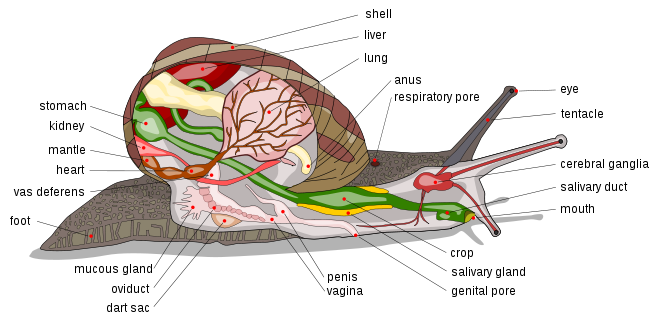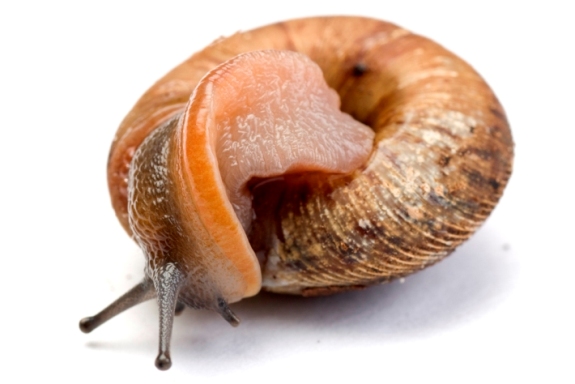Adaptation
All snails living on land have made many
adaptations to survive. Their main adaptation is their evolution
from aquatic organisms to terrestrial, or land, organisms.
They have done this by losing their gills and forming air
breathing lungs. The subclass
pulmonata and order Stylommatophora, to which Anguispira
alternata is classified,
have developed lungs instead of gills in order to breath on
land. Their mantle walls were vascularized to form a
pallial lung sac, also known as a pulmonary lung, which is regulated by
contractions of muscles in the mantle. The mantle of pulmonates also contains a small opening in order to breath in
oxygen and expel carbon dioxide.
Anguispira alternata is a model Stylommatophora. They do not have very unique characteristics but they have all they need to survive. Their shell acts as protection for their soft bodies and they can easily retract into their shell so most if not all of the body is sheilded. Surprisingly, most terrestrial snails have very good sensory and nervous systems. They have two sets of retractable tentacles, the longer tentacles have eyes at the top but are also used for smell while the shorter tentacles are used for sensing the substrate or food they are on and also for following the mucus trail of previous snails. Snails secrete a type of mucus or slime from their mucous gland. They do this so that they glide over different substrates. Snails move by muscle contractions throughout their foot and easily slide on their mucus.
Living in most of the United States, Anguispira alternata, and other terrestrial snails, have had to deal with extremely cold temperatures during winter. To do this, they go into a special hibernation to prevent from dying. During their hibernation, their hemolymph and other organic chemicals must be regulated so that their cells do not freeze and burst (Riddle, 1980). Hemolymph is a circulatory fluid that is rich with copper and carries oxygen throughout the body, just like blood does in humans. However, while humans have a separate fluid, plasma, in between their cells, hemolymph also plays the plasma role in snails. When winter is close, snails lower the levels of water within their body so that the water does not easily freeze. When they decrease water levels, only the now thick plasma like fluid, hemolymph, is left which does not freeze nearly as easy as water. The snails then supercool their bodies and cover themselves with a thick epiphragm. An epiphragm is a mucus or calcium carbonate layer that the snails cover their outside shell with that acts like a winter coat. After they put on their coat, the snails decrease their metabolic rate so no energy is wasted during winter. Some snails burrow into the ground for hibernation but some hibernate on the surface and even on trees. With some luck, the snails should survive the winter and once spring arrives, the snails quickly increase metabolic rate, rehydrate themselves, remove their epiphragm, and start looking for food.
Snails are generally very slimy which means they need a lot of water to keep hydrated. In times of drought, snails can not get the water that it needs so it goes into a dormancy state. Snails find a hard substrate and attach themselves, sealing off the opening of the shell. The snails then retreat into the back of their shell, slow their metabolism, and enter into a dormancy state until enough water is present for them to wake up and travel.
Speaking of food, Nutrition is next!
